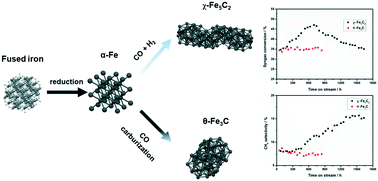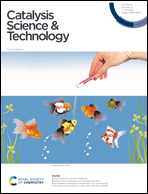Enhanced stability of a fused iron catalyst under realistic Fischer–Tropsch synthesis conditions: insights into the role of iron phases (χ-Fe5C2, θ-Fe3C and α-Fe)†
Abstract
The development of highly robust catalysts and understanding the deactivation mechanism of iron phases in Fischer–Tropsch synthesis (FTS), a core reaction to supply liquid fuels and hydrocarbons from syngas, has attracted immense interest from the real industrial application point of view. To elucidate the role of iron carbides and α-Fe phases on the FTS catalyst stability (1600 h on-stream), a fused Fe catalyst was reduced/carburized to produce two categories of uncarburized (α-Fe) and carburized (χ-Fe5C2, θ-Fe3C) catalysts at 300, 350 and 400 °C. The FTS catalytic results demonstrated that the uncarburized fused Fe catalyst (with χ-Fe5C2 as the main FTS active phase) displayed a volcano activity profile, while the carburized catalysts (with θ-Fe3C as the main FTS active phase) exhibited a levelled activity profile. The performed comprehensive characterization for the as-prepared/spent catalysts revealed that the improved FTS activity of the uncarburized catalyst is correlated with the increased surface area of iron carbide, while the obtained deactivation properties are ascribed to the oxidation of χ-Fe5C2 to the inactive Fe3O4 phase. However, the high resistance property of θ-Fe3C to the oxidation process is the main reason for the achieved outstanding stability of the carburized catalysts. Moreover, a positive correlation between the Fe3O4/χ-Fe5C2 phase content and the undesirable CH4 product selectivity is obtained; however, the θ-Fe3C phase has played a pivotal role in blocking the methanation process. This study will pave the way for better and clear understanding of the role of different iron phases in the stability/deactivation mechanism of FTS catalyst performance and processes.



 Please wait while we load your content...
Please wait while we load your content...